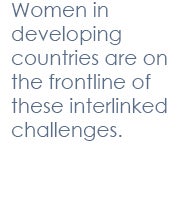Above, watch a panel discussion linking reproductive health, food security, and climate change in the lead-up to the United Nations Climate Change Conference, COP 20.
Policymakers typically address issues like climate, food security, development, and reproductive health separately. But that is not how those issues are experienced by women in developing countries. “At the ground level, these issues overlap 100 percent,” said Dr. Yetnayet Asfaw of EngenderHealth during a recent dialogue on global health and development held at the IMF/World Bank Annual Meetings’ Civil Society Policy Forum. At the event, which was organized by the Aspen Institute and Global Leaders Council for Reproductive Health and moderated by the Wilson Center’s Sandeep Bathala, several experts there urged action to make sure that women’s voices are heard in policymaking at all levels.
“We are at a pivotal moment for global development,” said Lucy Wangiru Njagi of the United Nations Development Program.

Right now, several global policy negotiations are nearing critical points. World leaders are preparing to meet in Lima in December, to hammer out an agreement on climate change to be ratified in Paris next year. At the same time there is a lively debate about what will replace the Millennium Development Goals, a wide-ranging set of world development goals to address poverty by 2015. And there is the unfinished business of the Cairo population conference: 20 years after a landmark agreement on family planning and reproductive health, there are still 222 million women who lack meaningful access to these services.
Women in developing countries are on the frontline of these interlinked challenges. For example, as climate change destabilizes rainfall patterns, women spend more time collecting water — some two to four hours each day, said Dr. Suzanne Petroni of the International Center for Research on Women. In sub-Saharan Africa, that adds up to 40 billion hours each year — the equivalent of the annual labor output of France.
Petroni observed that women are also most at risk in climate disasters, for a number of reasons: often they are not taught to swim, and their mobility is limited by caregiving responsibilities and traditional dress. And because women are responsible for 60 to 80 percent of subsistence agriculture — climate change profoundly affects their ability to put food on the table. The lack of reproductive health care compounds these problems because it is associated with poor health outcomes for women and children, and higher rates of poverty.
The convergence of these challenges makes women especially vulnerable, but it also means that women are key to creating solutions. In fact, they are already doing so.
“Grassroots women leaders are not waiting to be told what to do,” said Njagi. “They are already adapting to climate change, by experimenting with renewable energy and sustainable agriculture. But these practices need support.”
The most effective support comes from integrated programs that address these challenges in a holistic way. For example, population, health, and environment (PHE) programs combine voluntary family planning with natural resource management, gender equity, food security, and sustainable livelihood efforts. According to Clive Mutunga of USAID, “We now have two decades of experience with PHE that shows significant benefits over single-sector approaches.” As policymakers develop programs on climate adaptation, Mutunga added, they have much to learn from PHE.
Another inspiring example comes from the Sahel region, a belt of semi-arid land below the Sahara, which suffers from a chronic mix of poverty, food insecurity, drought, and conflict. And with a population expected to double by 2050, those challenges will only intensify.
Dr. Sennen Hounton of the United Nations Population Fund (UNFPA) described the Sahel Women’s Empowerment and Demographics Project — supported by UNFPA, USAID, the World Bank, and Sahelian governments — which is greatly improving reproductive health care in this troubled region. The Sahel project works the supply side of reproductive health by ensuring the availability of contraceptives and by building the pipeline of health care workers. It also addresses demand for services by strengthening girls’ education and by working with local leaders to change social norms around child marriage.
Improved access to reproductive health care will have enormous benefits for the women of the Sahel and for their families. It could also bend the curve of population growth in a region with some of the highest birthrates in the world. Slower growth, in turn, will make it easier for the nations of the Sahel to meet the food security and development challenges of the future.
In the Sahel, and around the globe, empowered women are better able to help solve the challenges of the 21st century. That means making sure that girls get an education and that women can make their own choices about marriage and childbearing. It means ensuring women’s full participation in economic and political life.
Fundamentally, it means that policymakers at all levels “must listen to what women are saying,” said Asfaw. “It’s as simple as that.”

